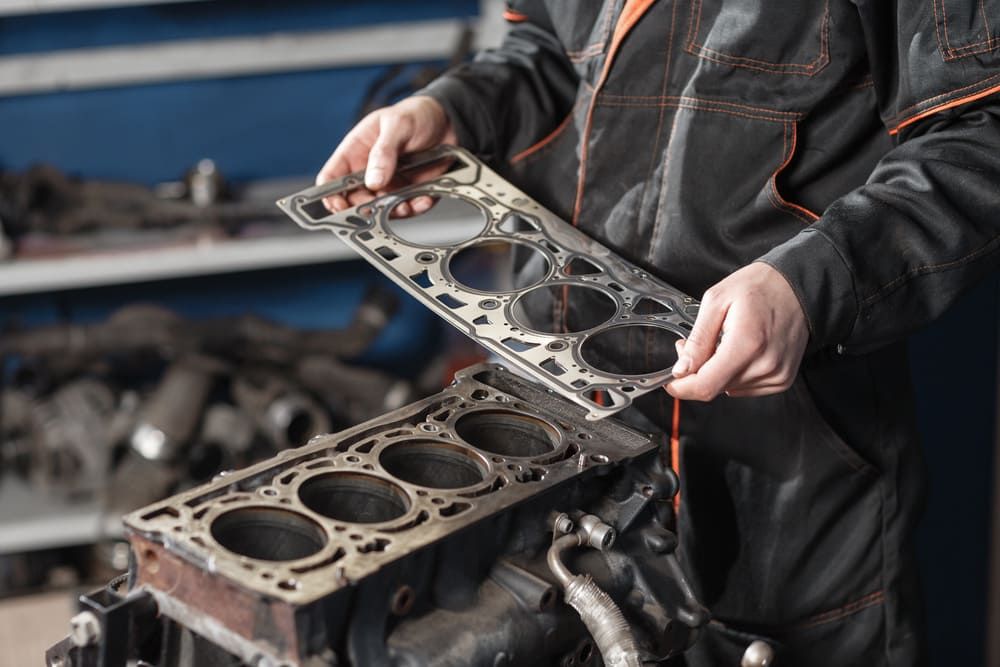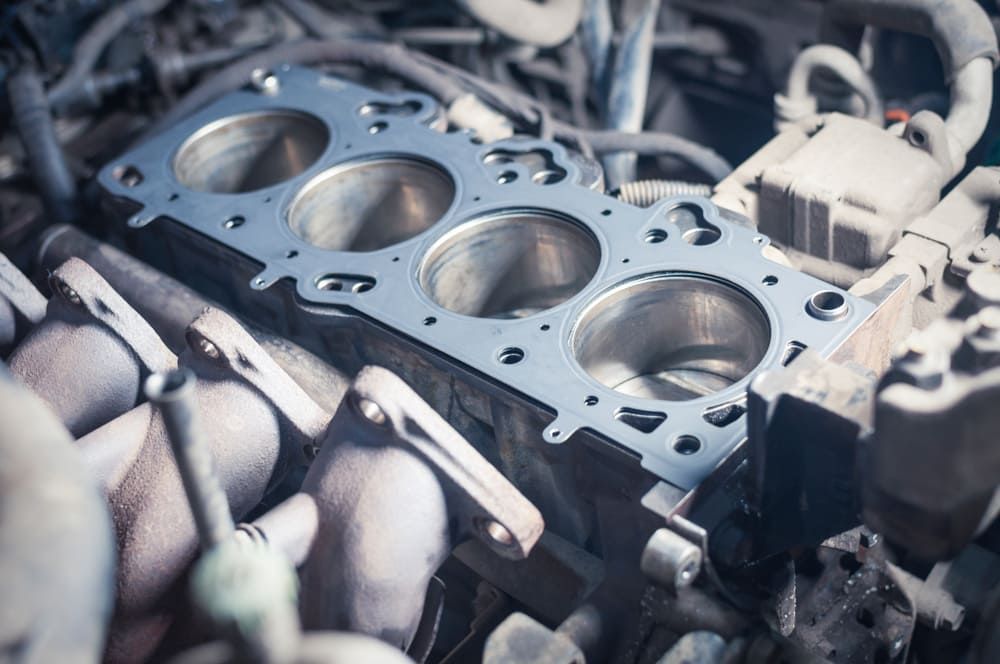>
Blog>
Head Gasket Repair and Replacement Cost GuideHead Gasket Repair and Replacement Cost Guide
If your head gasket is blown, or if you think it's about to fail, you’ll face a head gasket repair cost of £550 to £1,700.
A head gasket seals the engine to keep heat and pressure contained. If it fails, the engine can quickly lose performance or suffer serious damage
Understanding average head gasket replacement costs before requesting a quote helps you budget confidently and avoid overspending. Let’s begin with the UK head gasket repair costs.
Key takeaways
- How much does a head gasket repair cost?
- Head gasket repair cost for different car brands
- Head gasket repair cost by UK location
- Why is a new head gasket so expensive?
- Types of head gasket
- How do you repair a head gasket?
- Are there any additional head gasket repair costs?
- How long should a head gasket last?
- What are the signs of a blown head gasket?
- Can I drive my car with a blown head gasket?
- How long can you drive with a broken head gasket?
- Can you fix a blown head gasket without replacing it?
- Can I fix a head gasket myself?
- What causes a head gasket to fail?
- Does a blown head gasket mean I need a new engine?
- Is it worth getting a blown head gasket fixed?
How much does a head gasket repair cost?
Full-head gasket repair in the UK can cost between £550 and £1,700.
The amount typically depends on the region, type of car, and whether the engine has overheated.
A vehicle with an engine in any kind of ‘V’ arrangement, i.e. a V6 or V8, can cost considerably more, as they have two cylinder heads and two gaskets.
In many cases, removing the heads is often easier with the engine out.

Head gasket repair cost for different car brands
Head gasket repair costs often depend on your car type.
Here’s what UK drivers can expect to pay for a head gasket replacement for the following car manufacturers:
Head gasket repair cost by UK location
As with manufacturer types, head gasket repair costs can vary across the UK, with labour rates and parts availability influencing the final price.
Here’s a breakdown of estimated costs by location:
Why is a new head gasket so expensive?
Gasket repair costs a lot due to the expertise needed to repair it.
In car repairs, labour time drives up costs more than parts. A head gasket may cost £20, but replacing it requires extensive disassembly of the engine. The complexity of modern cars and their need for specialised tools or procedures make repairs even more expensive.
Gasket repairs can be unpleasant for your finances. But with Bumper, you can use car repair finance to split the costs into interest-free instalments.
Types of head gasket
There are different types of head gaskets. But, over time, head gasket designs have become more uniform, with most modern vehicles now using Multi-Layer Steel (MLS) gaskets.
Older types, now largely obsolete, include:
- Solid copper
- Asbestos-graphite composites
- Elastomeric steel designs
- O-ring gaskets
MLS gaskets feature up to five layers of steel and elastomer, coated with a specialised rubber finish. This construction allows them to withstand the high heat and pressure inside the engine, making them far more durable and reliable than previous versions.
How do you repair a head gasket?
You shouldn’t try to repair a head gasket yourself. An expert is always needed for this job!
Here are the main steps mechanics will take when repairing your car.
- Inspection — Your mechanic will investigate your blown gasket, paying special attention to the cylinder head.
- Replacement — The gasket will be replaced where needed. Other parts of the car may have been damaged, and these will also need repairs.
- Sealing — If the cylinder head is damaged, your mechanic may skim it to ensure the correct amount of connection.
- Connection — Your mechanic may also replace the cylinder head bolts. This isn’t always necessary.
- Completion — Once the new gasket is installed, your mechanic will complete a full inspection to ensure that there are no other problems.
Are there any additional head gasket repair costs?
There may be additional blown head gasket costs if your car has mechanical complications. To get an accurate quote, make sure your mechanic provides a very thorough examination.
These costs can be caused by:
- Engine inspection fees
- Replacing broken components (e.g. water pump or thermostat)
- Coolant and oil flushes
How long should a head gasket last?
The head gasket should last for at least 100,000 miles if the car is maintained well.
Some exceptions exist where manufacturers improperly specify the gasket materials. Still, more often than not, a head gasket will never need to be replaced if the car is maintained and cared for properly.
What are the signs of a blown head gasket?
Driving with a blown head gasket can cause serious engine damage, so it’s crucial to recognise the warning signs early.
Keep an eye out for the following signs:
- Reduction in engine power
- Smoke from under the bonnet
- Milky-coloured oil (Coolant mixed with oil)
- Smoke from the exhaust
- Overheating
- Unusual sounds (e.g., Gurgling, crackling, or hissing)
- Bubbles in radiator
What does milky oil mean?
Milky oil usually indicates that coolant has leaked into the engine oil. This mixture forms a white, frothy substance.
It signals serious engine problems, like a blown head gasket, so you shouldn’t ever ignore it.
Can I drive my car with a blown head gasket?
A head gasket can break in various ways, so the answer depends on the type of damage you have.
As a rule of thumb, avoid driving more than necessary. Overheating or significant coolant loss can dangerously overheat the engine and lead to other costly repairs.
How long can you drive with a broken head gasket?
You shouldn’t drive at all, as a broken head gasket can lead to further damage and unsafe driving conditions.
If you must, you might manage short distances at low speed, but continued use will worsen leaks and cause overheating. Complete engine failure is another real risk.
Overall, it’s best to repair the gasket before driving the car further.

Can you fix a blown head gasket without replacing it?
Some temporary gasket sealants claim to fix a blown head gasket without replacement, but these solutions are short-term and unreliable.
Realistically, they’ll stop minor leaks briefly, but the underlying damage and reason for the blown gasket remain.
For lasting repair and to avoid further engine damage, replacing the head gasket with proper mechanical work is the safest approach.
Can I fix a head gasket myself?
No. Replacing a head gasket is a complex, labour-intensive task that requires special tools and careful handling of engine components. More importantly, it needs mechanical expertise.
Any mistakes can cause severe engine damage and more costly repairs. For most car owners, it’s safer and more reliable to have a professional handle the repair.
What causes a head gasket to fail?
Head gaskets usually fail due to excess engine heat, often from a lack of coolant or poor engine care. Learn more below.
1. Overheating
Without coolant, the engine overheats, warping the block and cylinder head and creating gaps that let high-pressure gases escape past the gasket.
2. Not allowing your engine to warm up
Don’t over-rev a cold engine, as it can cause uneven heating, warping, or cracking.
Keep RPM below 3,000 until the engine warms, about 1–2 miles for petrol and up to 4 miles for diesel.
3. Improper engine timing
Ignition or timing faults, often from a stretched or skipped cambelt, can disrupt the combustion cycle.
Valves may close at the wrong time, causing pre-ignition, excessive pressure, and eventual gasket failure.
Does a blown head gasket mean I need a new engine?
This ultimately depends on the problem's severity and the cause of the gasket failure.
If the head gasket failed due to engine overheating, the cylinder head and block should be inspected. Severe overheating often warps the head beyond reuse, and the engine block may also crack or warp, necessitating the replacement of these parts.
Is it worth getting a blown head gasket fixed?
Yes. Fixing a blown head gasket is usually worth it if the engine is in good condition.
Repairing a head gasket restores performance and prevents further damage. Ideal if you want to keep your car on the road.
However, for older or heavily worn cars, repair costs may exceed the vehicle’s value. Assess your car’s overall condition before deciding on replacement.
Final thoughts
If your head gasket blows, you can suffer significant damage and even complete engine failure.
Getting the gasket fixed as soon as possible is critical. Hopefully, this article has pointed you in the right direction and helped you estimate your head gasket repair cost.
How Bumper can help
A head gasket repair cost can seriously ruin your week. But it doesn’t have to be catastrophic.
With Bumper’s car repair loan, you can split the cost of repairs into monthly payments at no extra cost.
Apply online for up to £5,000 and choose from 1,000s of trusted repairers.
Related Posts